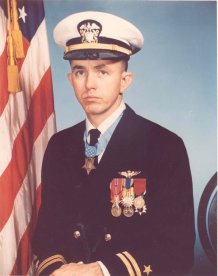Clyde Everett Lassen
Clyde Everett Lassen | |
|---|---|
 | |
| Born | March 14, 1942 Fort Myers, Florida |
| Died | April 1, 1994 (aged 52) Pensacola, Florida |
| Place of burial | Barrancas National Cemetery, Pensacola, Florida |
| Allegiance | United States of America |
| Service | |
| Years of service | 1961–1982 |
| Rank | Commander |
| Unit | Helicopter Support Squadron 7, Detachment 104, U.S.S. Preble (DLG-15) |
| Battles / wars | Vietnam War |
| Awards | Medal of Honor |
Clyde Everett Lassen (March 14, 1942 – April 1, 1994), a native of Fort Myers, Florida, was a Commander in the United States Navy and a Naval Aviator. As a Lieutenant, he received the Medal of Honor for his rescue of two downed Naval Aviators while piloting a search and rescue helicopter in Vietnam.
The mission
On June 19, 1968, Lassen, then a 26-year-old Lieutenant, junior grade flying a UH-2A Seasprite of HC-7 (assigned to the USS Preble), embarked on a mission to recover two downed Naval Aviators (from VF-33, off the USS America) whose F-4J plane had been shot down on a night interdiction mission deep inside North Vietnam. Upon reaching the hilly terrain where the aviators were hiding, Lassen made several attempts to recover the aviators, but dense tree cover, enemy weapons fire and intermittent illumination frustrated his efforts. Lassen turned on the landing lights of the helicopter, despite the danger of revealing his position to the enemy. After the pilots made their way to the helicopter and with his bullet-riddled helicopter dangerously low on fuel, Lassen evaded further antiaircraft fire before landing safely at sea on board the USS Jouett with only five minutes of fuel left in the helicopter's fuel lines. The account of the rescue was logged as a successful, routine search and rescue mission.
LT Lassen became the first Naval Aviator and fifth Navy man to be awarded the Medal of Honor (MOH) for bravery in Southeast Asia (SEA)/Vietnam. He was also only one of three Naval Aviators to be awarded the MOH in SEA (along with CAPT Michael J. Estocin, and RADM James Stockdale), and the only rotary wing Naval Aviator to be awarded the MOH in SEA.
He remained in the Navy and retired in 1982 with the rank of Commander. He lived in Pensacola, Florida until his death from cancer in 1994. In 2001, the destroyer USS Lassen was commissioned and named in his honor.[1] An SH-60 Seahawk was painted to commemorate his actions.[2]
Awards and decorations
Medal of Honor


Citation:
For conspicuous gallantry and intrepidity at the risk of his life above and beyond the call of duty as pilot and aircraft commander of a search and rescue helicopter, attached to Helicopter Support Squadron 7, during operations against enemy forces in North Vietnam. Launched shortly after midnight to attempt the rescue of 2 downed aviators, Lt. (then Lt. (J.G.)) Lassen skillfully piloted his aircraft over unknown and hostile terrain to a steep, tree-covered hill on which the survivors had been located. Although enemy fire was being directed at the helicopter, he initially landed in a clear area near the base of the hill, but, due to the dense undergrowth, the survivors could not reach the helicopter. With the aid of flare illumination, Lt. Lassen successfully accomplished a hover between 2 trees at the survivors' position. Illumination was abruptly lost as the last of the flares were expended, and the helicopter collided with a tree, commencing a sharp descent. Expertly righting his aircraft and maneuvering clear, Lt. Lassen remained in the area, determined to make another rescue attempt, and encouraged the downed aviators while awaiting resumption of flare illumination. After another unsuccessful, illuminated rescue attempt, and with his fuel dangerously low and his aircraft significantly damaged, he launched again and commenced another approach in the face of the continuing enemy opposition. When flare illumination was again lost, Lt. Lassen, fully aware of the dangers in clearly revealing his position to the enemy, turned on his landing lights and completed the landing. On this attempt, the survivors were able to make their way to the helicopter. En route to the coast he encountered and successfully evaded additional hostile antiaircraft fire and, with fuel for only 5 minutes of flight remaining, landed safely aboard USS Jouett (DLG-29).
Commendations
CDR Lassen's awards include the following:[3]

| |||||
| Badge | United States Navy Aviator Badge | |||||||||||
|---|---|---|---|---|---|---|---|---|---|---|---|---|
| 1st Row | Medal of Honor | Bronze Star with "V" device | ||||||||||
| 2nd Row | Air Medal with Award numeral 1 |
Navy Presidential Unit Citation | Navy Good Conduct Medal | |||||||||
| 3rd Row | National Defense Service Medal | Vietnam Service Medal with 1 silver Campaign star (indicating 5 stars total) |
Vietnam Campaign Medal with "60-" clasp | |||||||||
See also
Notes
- ^ "Navy to Commission Guided Missile Destroyer Lassen". Abilene Reporter-News. April 19, 2001. Archived from the original on January 8, 2006. Retrieved May 14, 2006. (posted on Home of Heroes.com)
- ^ "SH-60F of HS-10 Warhawks". Retrieved December 4, 2011.
- ^ "Lassen, Clyde Everett, CDR". navy.togetherweserved.com. Retrieved February 1, 2021.
References
- This article includes text in the public domain published by the United States Navy.
- ""Medal of Honor recipients of the U.S. Navy in Vietnam",". By Sea, Air, and Land. Naval Historical Center, Department of the Navy. Retrieved May 14, 2006.
- "USS Lassen Namesake". United States Navy. Archived from the original on December 7, 2006. Retrieved September 24, 2010.
- 1942 births
- 1994 deaths
- United States Naval Aviators
- United States Navy Medal of Honor recipients
- People from Fort Myers, Florida
- United States Navy officers
- Recipients of the Air Medal
- United States Navy personnel of the Vietnam War
- Vietnam War recipients of the Medal of Honor
- Deaths from cancer in Florida
- Burials at Barrancas National Cemetery
